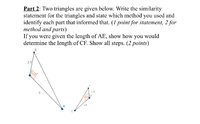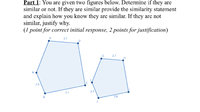You are using an out of date browser. It may not display this or other websites correctly.
You should upgrade or use an alternative browser.
You should upgrade or use an alternative browser.
Triangles proportions
- Thread starter Faye
- Start date
Well, considering you have 30 posts here (meaning you've definitely read the Rules by now) and you've shown no work of your own, I'm forced to conclude you have no work to show and you're stuck at the very beginning. That's okay, I can work with that. A great place to start any math problem is to ensure that you know the definition of any terms used in the problem. In this case, you need to know what similar triangles are and how you can tell if two triangles are similar. In case you're finding your textbook and/or class notes insufficient to review this information, here's a handy webpage I found.
Based on this review you just conducted, what must be true of the angle(s) in similar triangles? And what must be true of the side(s) of similar triangles? How might this help you answer the first problem? The second problem's a bit more difficult because it involves a pentagon, but if you add in a couple of new lines (probably best to draw them dashed or something) you'll see that you can divide the pentagons into three triangles. Once you've done that, you should also be able to use your newfound knowledge to solve the second problem.
So go ahead and give these problems your best shot. If you get stuck again, that's alright, but when you reply back, please include any and all work you've done on them, even including the parts you know for sure are wrong. Thank you.
Based on this review you just conducted, what must be true of the angle(s) in similar triangles? And what must be true of the side(s) of similar triangles? How might this help you answer the first problem? The second problem's a bit more difficult because it involves a pentagon, but if you add in a couple of new lines (probably best to draw them dashed or something) you'll see that you can divide the pentagons into three triangles. Once you've done that, you should also be able to use your newfound knowledge to solve the second problem.
So go ahead and give these problems your best shot. If you get stuck again, that's alright, but when you reply back, please include any and all work you've done on them, even including the parts you know for sure are wrong. Thank you.
No, it wasn’t that I didn’t want to do any work I actually fell asleep working on my mods for a Geometry I had been going for 12 hours straight. I am looking at the post nowWell, considering you have 30 posts here (meaning you've definitely read the Rules by now) and you've shown no work of your own, I'm forced to conclude you have no work to show and you're stuck at the very beginning. That's okay, I can work with that. A great place to start any math problem is to ensure that you know the definition of any terms used in the problem. In this case, you need to know what similar triangles are and how you can tell if two triangles are similar. In case you're finding your textbook and/or class notes insufficient to review this information, here's a handy webpage I found.
Based on this review you just conducted, what must be true of the angle(s) in similar triangles? And what must be true of the side(s) of similar triangles? How might this help you answer the first problem? The second problem's a bit more difficult because it involves a pentagon, but if you add in a couple of new lines (probably best to draw them dashed or something) you'll see that you can divide the pentagons into three triangles. Once you've done that, you should also be able to use your newfound knowledge to solve the second problem.
So go ahead and give these problems your best shot. If you get stuck again, that's alright, but when you reply back, please include any and all work you've done on them, even including the parts you know for sure are wrong. Thank you.
In similar triangles, corresponding angles are equal and sides have the same ratio. I’m working on the problem now and thank you.No, it wasn’t that I didn’t want to do any work I actually fell asleep working on my mods for a Geometry I had been going for 12 hours straight. I am looking at the post now
Faye, I believe you...No, it wasn’t that I didn’t want to do any work I actually fell asleep working on my mods for a Geometry I had been going for 12 hours straight.
So, the first problem. PART 1: I figured out they are not similar because the ratio of the corresponding sides isn’t proportional which is called the scale factor.
For example: 5.1/3.6 = 2.8/2.1 = 3.7/2.7(This isn’t true so the figures aren’t similar)
PART 2: These triangles are similar Because 125 equals 125 on both triangles and the corresponding sides are in the same proportion.
1.3/2.5= 2.6/5
If we are given the length of E, we would find CF from the equation:
1.3/2.5=CF/AE
CF=(1.3*AE)/2.5
For example: 5.1/3.6 = 2.8/2.1 = 3.7/2.7(This isn’t true so the figures aren’t similar)
PART 2: These triangles are similar Because 125 equals 125 on both triangles and the corresponding sides are in the same proportion.
1.3/2.5= 2.6/5
If we are given the length of E, we would find CF from the equation:
1.3/2.5=CF/AE
CF=(1.3*AE)/2.5
So, the first problem. PART 1: I figured out they are not similar because the ratio of the corresponding sides isn’t proportional which is called the scale factor.
For example: 5.1/3.6 = 2.8/2.1 = 3.7/2.7(This isn’t true so the figures aren’t similar)
PART 2: These triangles are similar Because 125 equals 125 on both triangles and the corresponding sides are in the same proportion.
1.3/2.5= 2.6/5
If we are given the length of E, we would find CF from the equation:
1.3/2.5=CF/AE
CF=(1.3*AE)/2.5
Looks good to me. I reach the same conclusions. Good job!


